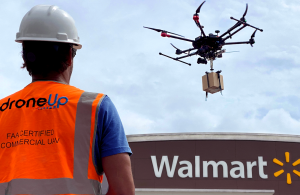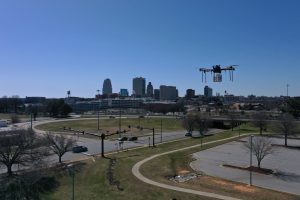Canada is getting ready to deliver significant changes to the country’s drone regulations. The changes could open up a multi-million-dollar opportunity for businesses and investors active in various sectors, including supply chain management, package delivery, environmental monitoring, infrastructure maintenance and repair, emergency and first responder support and more.
That’s if, and when, the next Prime Minister and/or governing party in power gets on board.
The anticipated changes to drone rules include updates to “beyond visual line-of-sight” (BVLOS) operations to enable longer, more demanding drone missions. There are also new weight regulations, as well as enhanced safety rules for drones operating in crowded urban spaces or remote regions of the country.

Canadians are expecting new drone regulations that could open up a multi-million-dollar opportunity for businesses and investors. Image Drone Delivery Canada, DDC Canary RPA (CNW Group/Drone Delivery Canada Corp.)
“The proposed regulations, with a focus on mitigating safety risks while also supporting economic growth and innovation, would provide direct benefits to Canadians and unlock significant economic opportunities in Canada” said then-Transport Minister Omar Alghabra a couple of years ago, when the rule changes were first being proposed by the Trudeau government. Anita Anand then took over the Transport Ministry and she supported the drone rule change process, but she announced her decision to retire earlier this year. Of course, the Prime Minister has also announced he’s stepping down, so a new Liberal leader may call or soon face an election (Anand, by the way, has apparently reversed her decision and announced intention to seek re-election).
Under the new regulations, drone operators in Canada (Transport Canada has registered more than 100,000 remotely piloted aircraft systems and counting) will still be required to get a drone pilot certificate and register drones to operate in certain weight categories.
The new regulations increase maximum weight allowances to 150 kilograms, supporting a range of new industrial and commercial applications. The consumer or hobbyist operators who use drones weighing less than 250 g need not be licensed or registered.
April 1, 2025, was the previously announced date for full implementation of the new drone regulations (some were in place in late 2024). When they are finally implemented as tabled, the drone delivery industry in Canada is set to take off: according to some industry estimates, the current $40 million or so market will grow to more than half a billion dollars in just five years!
Waiting for final passage of the new regulations is not to say that important drone delivery services – life-saving services, in fact – have not already been completed in Canada. Drones have helped modernize healthcare logistics and transform healthcare delivery by getting essential supplies to remote or hard-to-reach areas. In emergencies, drones with medical supplies, including blood, vaccines, and medications, can bypass roadblocks or other land travel disruptions, providing urgently needed items faster than ground transportation.
Canadian experience and know-how has been demonstrated in such real-world applications.
For example, Vaughan, ON-based Drone Delivery Canada Corp. has flown critical medical supplies to remote communities in northern Ontario, using a system that enabled the safe use of remote-controlled drones flown outside the pilot’s line of sight. The service was approved on a case-needed basis.

Drone Delivery Canada’s DroneCare project uses a patented drone delivery solution to establish a transportation link between two Halton, ON, hospitals, Milton District and Oakville Trafalgar Memorial. (CNW Group/Drone Delivery Canada Corp.)
Likewise, through a pilot program conducted by staff at the University of British Columbia and residents of the Stellat’en First Nation in northern British Columbia, over 1,200 BVLOS drone flights successfully delivered medications to residents hindered by poor health or harsh weather. The First Nation joined in a $750,000 Remote Communities Drone Transportation project to make medical services more accessible to rural areas during the COVID-19 pandemic.
Also in BC, residents and health care providers on Penelakut Island were able to get invaluable medications and test results to their isolated location thanks to Nepean, ON-based InDro Robotics, which deployed drones equipped with real-time video streaming capabilities (needed to enable BVLOS drone operations) during the pandemic.
Drone Delivery Canada, by the way, recently announced a merger with fellow Canadian aerospace service provider Volatus Aerospace Group to commercialize what’s called the Volatus Aerieport Drone Nesting Station, a built structure where BVLOS drones can rest, park and wait for their next assignment. The drone-agnostic structures are weatherproof, able to be operated remotely 24/7, all while enabling drone delivery and service flights in greater frequency and reliability.

Walmart says it is still committed to drone services, but its DroneUp service has gone down.
In the U.S., major retailers have long dabbled in consumer-oriented drone delivery – but some have already backed out.
Walmart’s 2021 experiment with drone delivery services has come to an end, although the company says it is still committed to drone services. The initial service maxed out at nearly two million homes in and around Dallas, TX.
Amazon says it wants to deliver 500 million packages globally by the end of the decade, and its Amazon’s Prime Air drone delivery service in the U.S. southwest boasts delivery (items weighing five pounds or less) in under an hour to eligible customers.

Drone Express and its partner AeroX use autonomous drones to deliver snacks, sweets, pet supplies and more in just 15 minutes.
And Drone Express is using drones to deliver grocery products, in loads up to 10 pounds, suspended from their underside. The company first worked with the Kroger retail chain, and then with Papa John’s and Wind Supply, a construction materials distributor. Drone Express and its partner AeroX have used autonomous drones to deliver snacks, sweets, pet supplies and more in just 15 minutes, thanks to a network of ground tracking stations, lightweight capacities, and mobile tracking app.
Meanwhile, project trials, phases, and implementations in the Canadian Remotely Piloted Aircraft System (RPAS) RPAS traffic management project (its aim was to have an unmanned traffic management system in place across urban areas of the entire country by 2025) involve many of the country’s top drone operators, developers and infrastructure operators.
Transport Canada and NAV CANADA have worked, for example, with Canada’s Variable Pitch Inc. and an international consortium of drone operation companies, including Canadian firms Accipiter Radar and InDro Robotics, to allow drones to safely operate alongside planes and helicopters.
Other key players contributing to the Canadian RPAS traffic management project include Halifax, NS-based AeroVision Canada, a specialist in Visual Line of Sight (VLOS) operations for drones under 25 kg., as well as ANRA Technologies, ClearSky Connect, and others.
In addition to the federal initiatives, provinces are also diving into the drone delivery business. In Alberta, for example, drone management company AIRmarket Inc. is working with the government on a multimillion-dollar project called “Air Traffic Control for Drones”, which will see nearly $5 million invested into deployment of remote pilot aircraft and BVLOS system traffic management infrastructure throughout the province.
In partnership with Alberta Wildfire, heavy-lift drones will transport essential supplies to hard-to-reach wildfire areas, reducing reliance on crewed aircraft, and, the government says, saving nearly 90 tonnes of carbon emissions each year from an expected 100,000 daily flights.
That’s a delivery worth waiting for.
-30-



